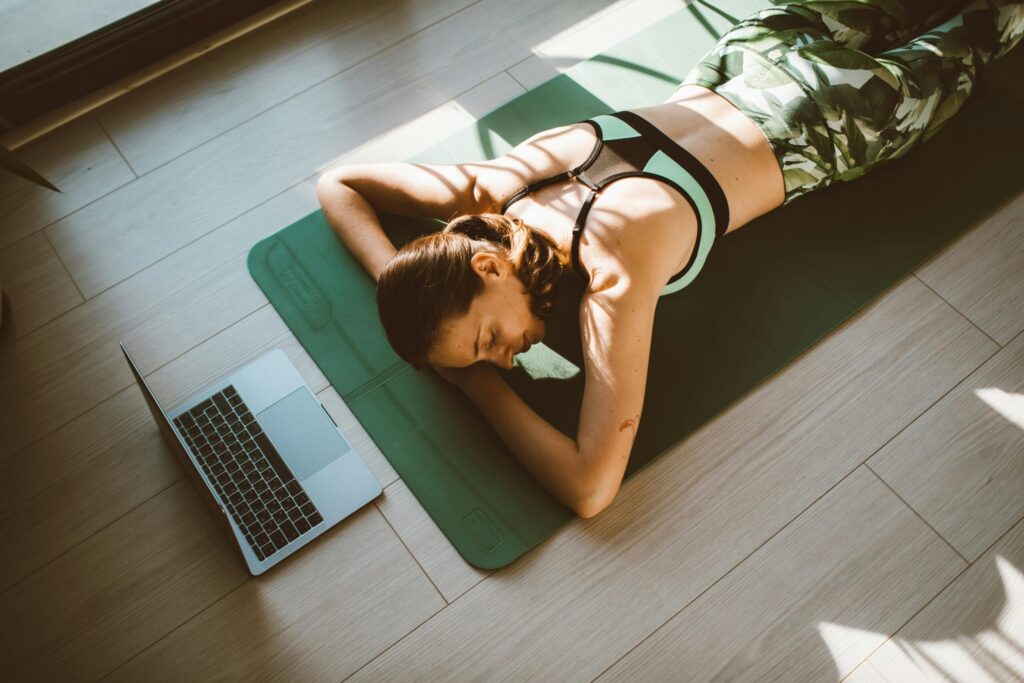The world can take care of itself for a few minutes.
(Photo: ROMAN ODINTSOV | Pexels)
Published November 13, 2025 09:44AM
Are you spending tons of time with family and friends? Feeling forced to socialize at work events? Finding yourself in more situations that require you to paste on a smile and be a little more outgoing than you’d like?
Chances are you’re experiencing the stress and exhaustion of constantly being “on,” otherwise known as social burnout. Although you can’t always skirt your way around social obligations (or come up with a really good excuse to miss them), there is a way to release pent-up energy and calm yourself before and after.
Replenishing might take the form of a quiet moment away from distraction and a chance to truly inhale. “Lots of talking equals lots of exhaling, and most people don’t make a point of consciously inhaling at social functions,” says Jeanne Heileman, a longtime yoga teacher trainer whose approach focuses on the subtle body. This can drain the battery of your prana, or life force, explains Heileman. “When we overuse our voice or overstimulate our senses, then we need to draw inward,” she says.
In other words, it isn’t just your own talking that drains your energy; it’s other people talking to you, as well as your surroundings—loud music, bright lights, and the collective energy of a room—that can leave you feeling deflated.
So next time you experience that sense of overwhelm that makes you feel as if you can’t take a full breath, try this short practice to ground, go inward, and restore.
15-Minute Sequence for Social Burnout
In this practice, you’ll move through low-to-the-mat poses with plenty of time to take long, slow, deep breaths. Grab a couple bolsters, couch cushions, or folded blankets and four blocks or small stacks of books.
If it’s feasible, make your environment as calm as possible. Can you close the door? Turn off your phone? Dim the lights or light a candle? However you choose to practice, make this your time to tend to your needs—and let go of the busyness and noise of the outside world.

1. Supported Child’s Pose
Place a bolster or cushion lengthwise on the mat. Come to your hands and knees with the bolster underneath you, then sink your hips toward your heels and lower your chest onto the bolster. Rest your arms in front of you on the mat with your elbows slightly bent and your palms on the mat. Rest your forehead on the bolster or bring one cheek to the bolster in Supported Child’s Pose. Close your eyes or soften your gaze. Breathe here for a minute or more. If your head is turned to one side, turn your head to bring the opposite cheek to the bolster about halfway through.

2. Supported Crocodile Pose
Come to your hands and knees, then lower yourself onto the bolster so your chin meets its front edge. Separate your legs so they’re wider than hip-width apart, straighten them, and let your heels turn out slightly. Gently grasp opposite elbows and lower your forearms to the mat or a folded blanket. Rest your forehead on your forearms. Allow yourself to sink against the bolster. Stay here for a minute or longer.
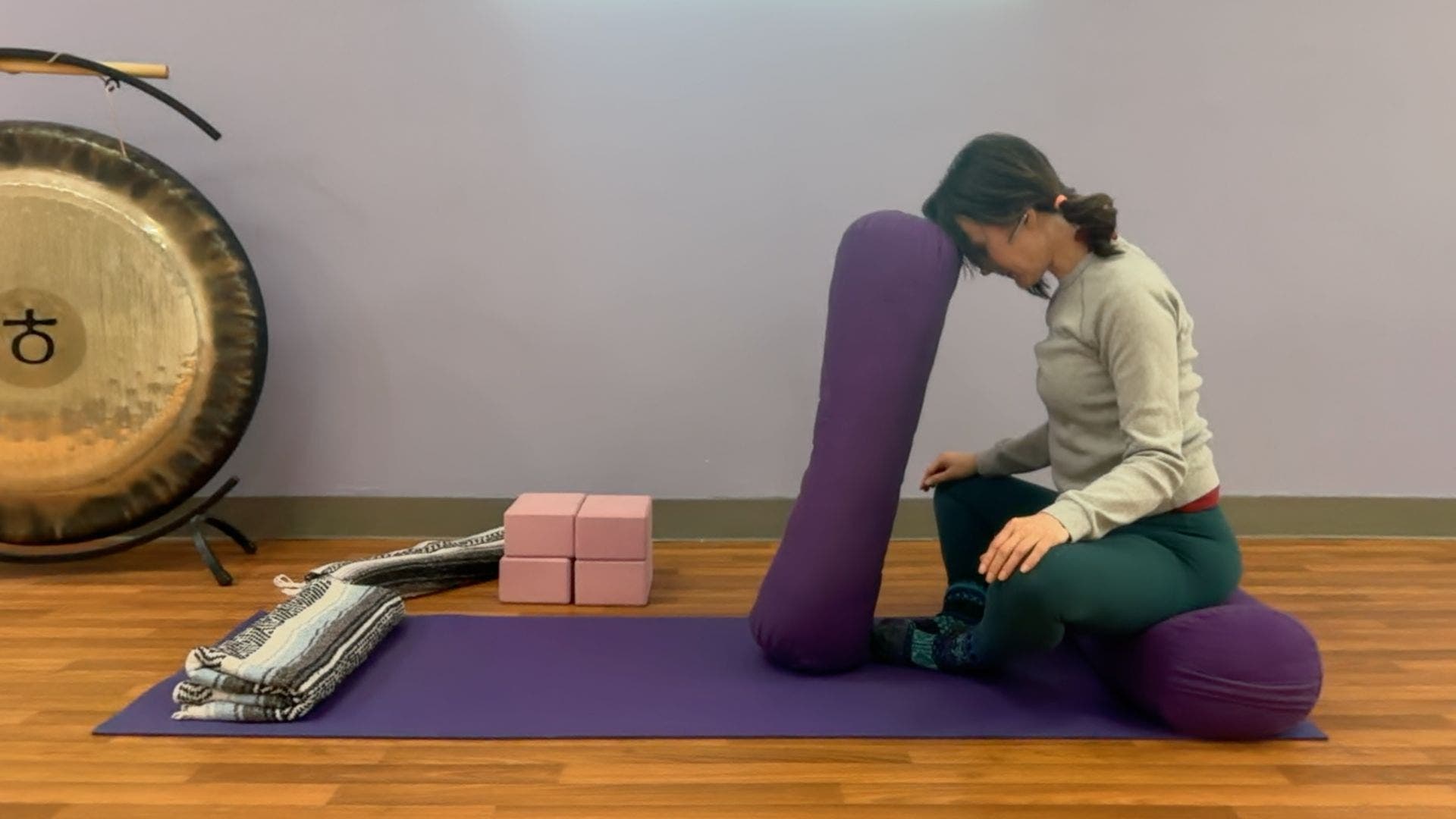
3. Supported Bound Angle Pose
Sit on the mat or a bolster. Bend your knees and draw the soles of your feet together. Place cushions, folded blankets, or books underneath your knees for a less intense stretch. Position a bolster or cushion lengthwise on the mat about 12 inches in front of you. Rest the far short end of the bolster on the mat, then angle it upward and toward you to meet your forehead. Gently tuck your chin. Rest your hands on your thighs. Settle into the pose, breathing here for a minute or so.
Slowly sit upright, then straighten your legs in front of you and gently shake them out.

4. Supported Wide-Legged Forward Bend Pose Variation
Sit on the mat or a folded blanket and separate your legs into a V position. Place a bolster or cushion on top of your right thigh. Rest your right forearm on the bolster. Reach your left hand overhead and toward the right in this Wide-Legged Forward Bend variation.
For a less intense variation: Bend your right knee and plant your right foot on the mat.
For a more intense sensation, grasp your left hand with your right hand as you stretch even more to the right.
Take several breaths here, then switch to the opposite side.
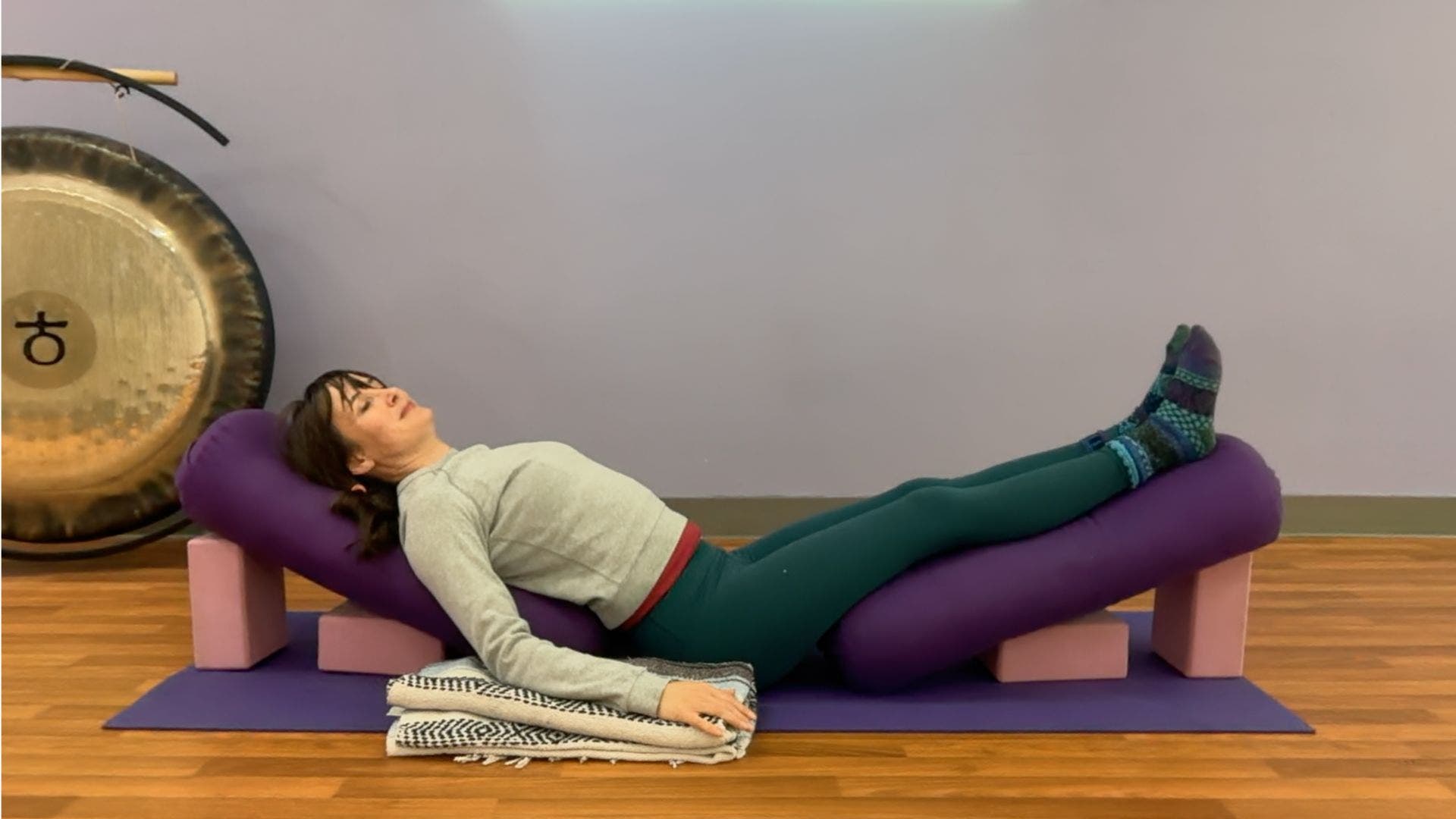
5. Supported Boat Pose
Place 2 bolsters or cushions lengthwise on the mat in a single line, leaving a little space in between. Place 2 blocks or stacks of books under each bolster so the outside edges are higher and the inside edges rest against the mat. They should form a V shape. Sit in the space between the bolsters with one behind you and one in front of you. Lie back against one bolster and gently draw your legs up the other, letting your forearms rest on the mat or on folded blankets in Supported Boat Pose. Keep your gaze soft or close your eyes for a minute or more.

6. Restorative Bridge Pose
Position your bolster or cushion lengthwise on the mat. Sit down midway on the bolster. Lie down so the bolster supports your mid-back and your shoulders, arms, and the back of your head rest comfortably on the mat. Straighten your legs and rest your heels on the mat or place your feet on the floor and bend your knees toward the ceiling in Restorative Bridge Pose. Breathe here for a minute or more, then press your forearms into the mat to rise to a seated position.
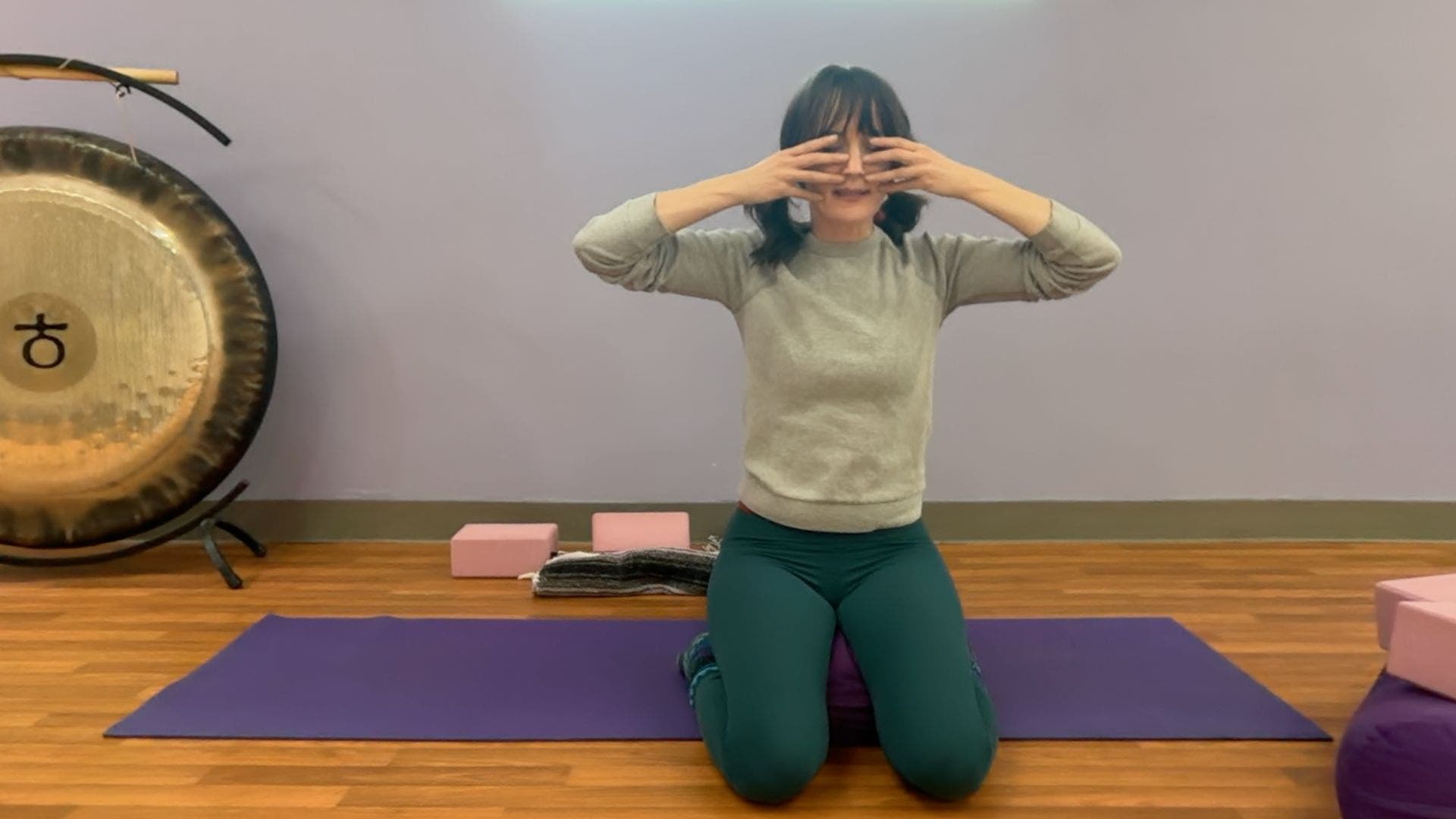
7. Hero’s Pose With Breathwork
Kneel on the mat and lower your hips between your heels and onto a bolster, block, or the mat. If this is uncomfortable, you can sit in any comfortable position.
Bhramari Breath and Shanmukhi Mudra
Bring your palms toward your face and gently touch your index fingertips to your eyelids. Rest the rest of your fingers along the outside of your nose and nostrils and above and below your lips. Touch your thumbs against the cartilage in front of your ears. Inhale and pause briefly, then exhale as you vocalize a hum sound. Allow this sound to clear any thoughts or outside noise from your mind. Repeat this mantra for a minute or more.
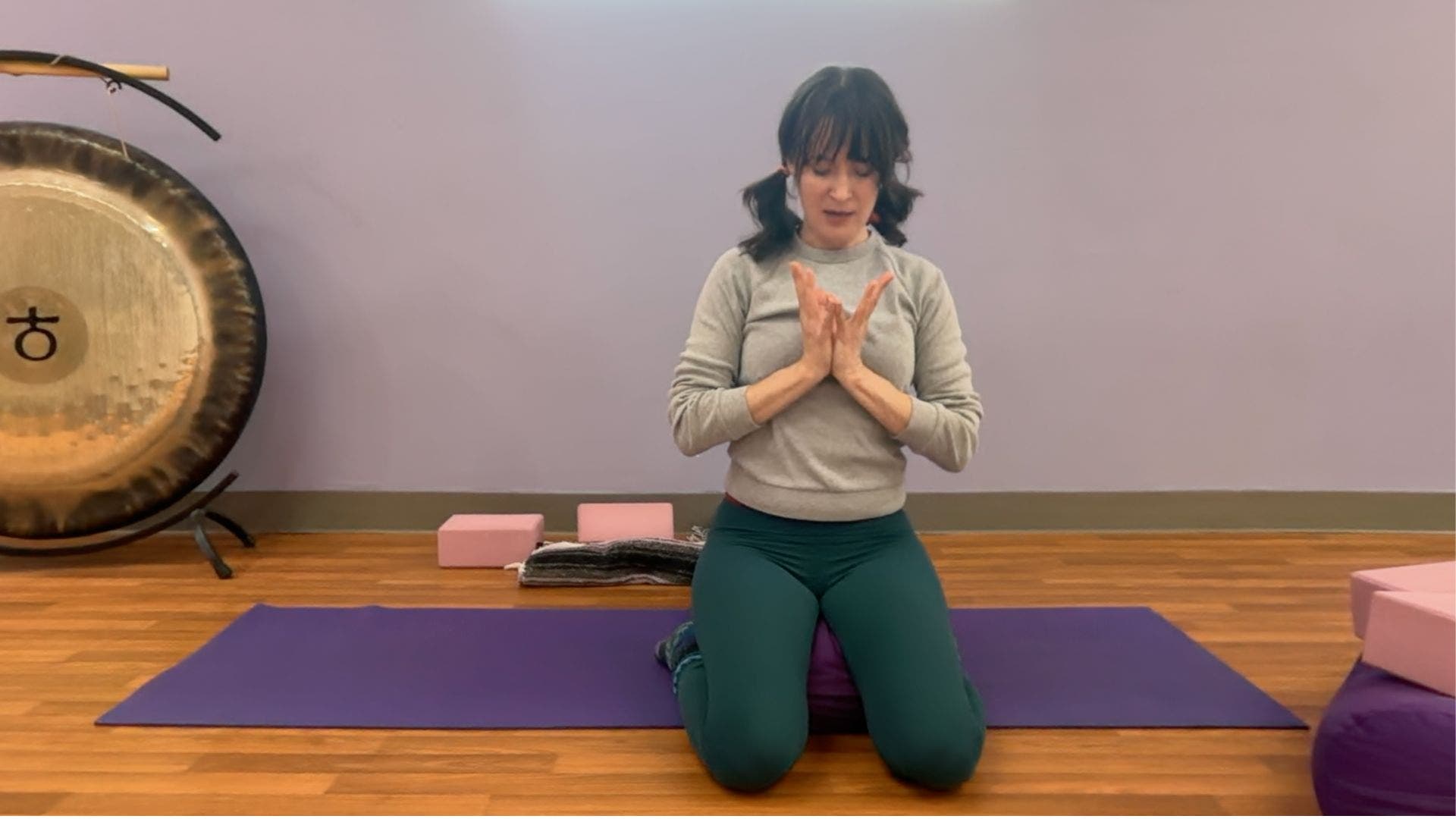
8. Seated With Lotus Mudra
Remain seated and bring your hands to your chest in prayer position (anjali mudra). Keep the heels of your hands and pinky fingers together as you separate your palms and spread your fingers to create a shape that looks like a flower or cup. This gesture is one of receiving. Imagine light flooding into your hands and from them, warming your face and expanding outward to illuminate the world and the people in it…from a safe distance, of course.


